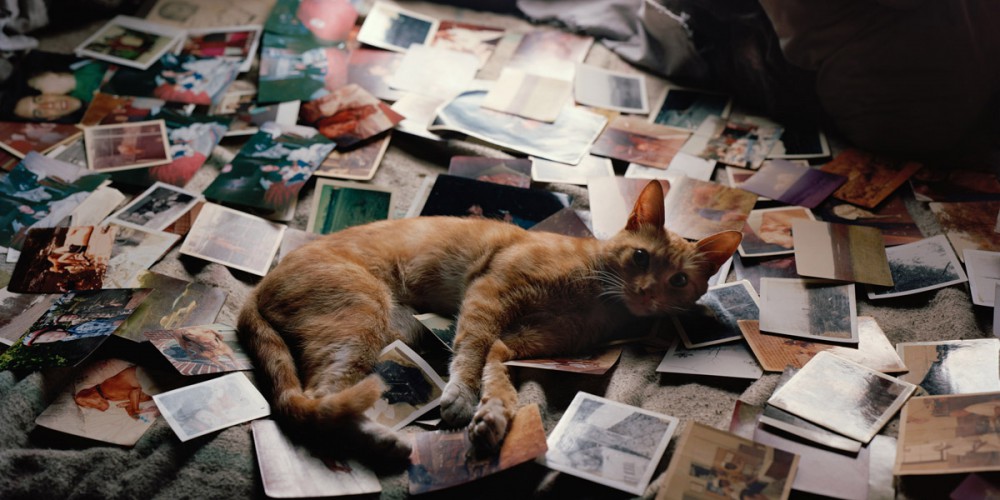
Jeffrey Stockbridge on the Pleasures of Analog Photography
This spring, we noticed Jeffrey Stockbridge – a Philadelphia-based photographer and a 2006 Wind Challenge Artist- in Ahmed Salvador’s Darkroom: Color Photography class. A graduate of Drexel University, Jeffrey has exhibited his work at The National Portrait Gallery London, The Philadelphia Museum of Art, The Delaware Art Museum, The Wapping Project Bankside, and The Print Center. We sat down with him for a brief chat about one of his most well-known projects, Kensington Blues, his continued interest in analog photography, and why anyone studying photography should spend some time in the darkroom.

Top: Al’s Cat, 2014. Above: Diana with her kids, 2013
Tell us about your experience in Fleisher’s darkroom and the color photography class you took with Ahmed Salvador this spring.
Getting back into the darkroom was a great experience. It had been over 10 years since I made a traditional print! When I graduated from the Drexel photography program back in 2005, most of my class was already printing digitally and I continued to print this way for a long time without considering darkroom printing. My friend and talented photographer Hannah Gaudite signed up for Ahmed’s class and recommended it to me. Feeling burnt out by the endless possibilities of digital printing, I signed up, too. The darkroom has been good for my soul. It’s so nice working in a traditional process to make images come to life. It is far simpler than digital printing and the results are uniquely special.
Do you see your recent experiences in the darkroom having an impact on your process or the trajectory of your work?
I’ve been printing a series I shot in Indonesia last year. I’m making small, 6×6 inch prints that are delicate and one of a kind. If anything, this class has reminded me to slow down and appreciate the process rather than just trudge along to get a desired result.
In your celebrated documentary project Kensington Blues you photographed with a film 4×5 camera. Can you tell us a little about this process and why you choose it specifically for this project?
When you shoot 4×5 film it takes time. And that’s exactly what I was trying to spend in Kensington. I needed a process that was slow so that I could engage with people. The camera is unique and old-timey looking so it gets a fair amount of attention and people feel respected when I photograph them with it. It’s one sheet of film at a time. Everyone’s gotta hold still. And here’s a population that’s constantly on the move. Drug addicts and prostitutes that need to make quick money so they can score their next fix. They’re stuck in this cycle they can’t easily escape from. Stopping for 20 minutes to be interviewed and have their photograph taken was a cathartic experience for them. Shooting with the 4×5 enabled me to create the right environment to put them at ease and make a real connection.
A 4×5 camera only uses fixed lenses, no zooms allowed. This is important because it teaches you where to stand. For portraits, I shoot mostly with my 150mm lens, which is considered a normal lens, with an angle of view approximate to human vision. That usually puts me somewhere between 3 and 8 feet from my subject, which is right where I want to be.

Crystal, 2012.
Do you continue shooting film in your other work?
I am predominantly a film shooter. Apart from the cool cameras I get to use, (Hasselblad, Mamiya 7II, and my 4×5) shooting film has taught me to pay more attention to my subject. When you’re shooting digital it’s so easy to get obsessed with looking at the image on the screen. When you’re doing that, you’re ignoring everything that’s happening right in front of you. I catch myself doing this all the time on commercial jobs. But when I’m shooting film on a personal project, there is no LCD, and there is no distraction. It’s all about being present and connecting with your environment. I’ll look at the images later, once the experience is over.
You work with a lot of local artists, editing and printing their work at your studio, Stockbridge Fine Art Print. Are many of them still invested in film technology?
Yes, very much so. Many of my clients shoot film for the same reasons I do. Apart from shooting though, the quality of film properly scanned for digital output can far exceed current digital camera technology. We scan negatives on an Imacon Flextight and it produces amazing results.
With the ease and affordability provided by digital photography, would you encourage someone to get hands on experience in the darkroom?
Absolutely. The darkroom experience really teaches you how to think about photography, one frame at a time. It’s the best way to learn the basic skills necessary before you enter the digital realm.

Charlie, 2012.


To get updates on events, exhibitions & class information:
"*" indicates required fields